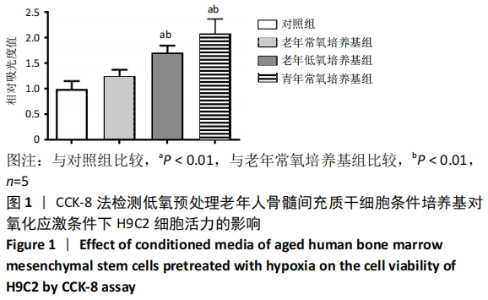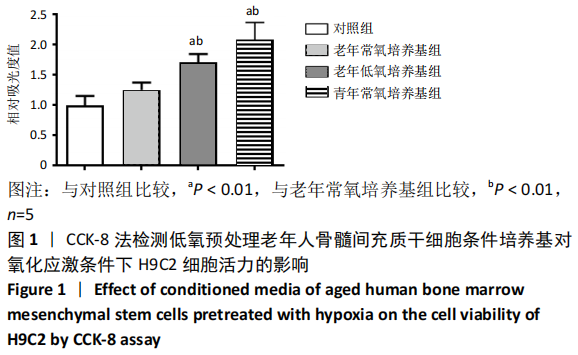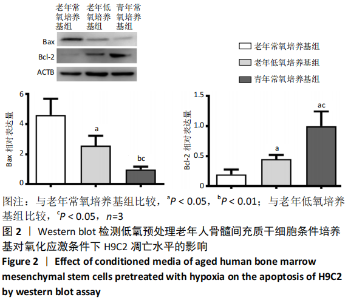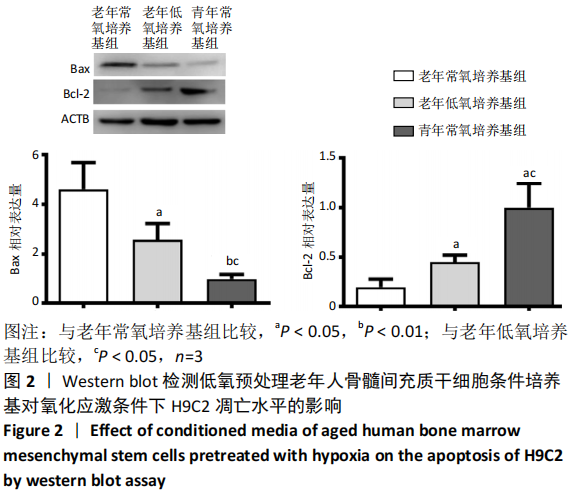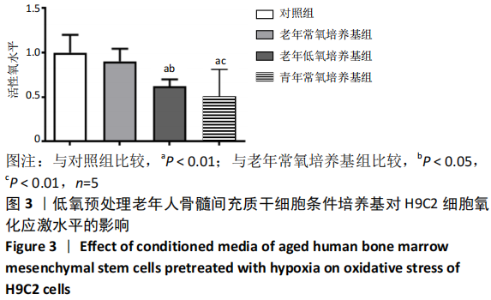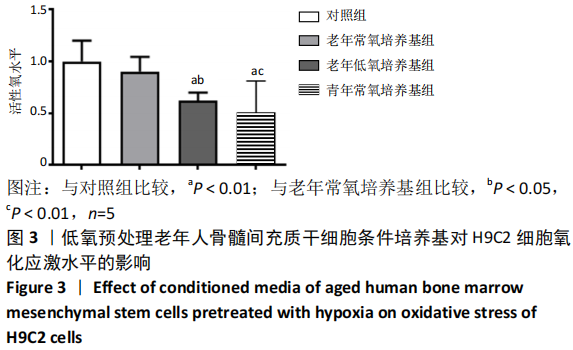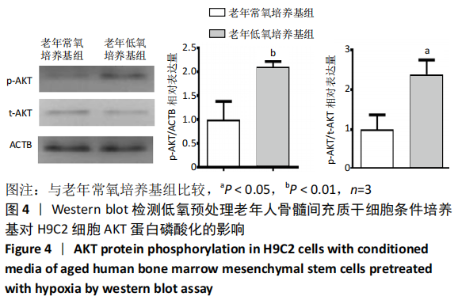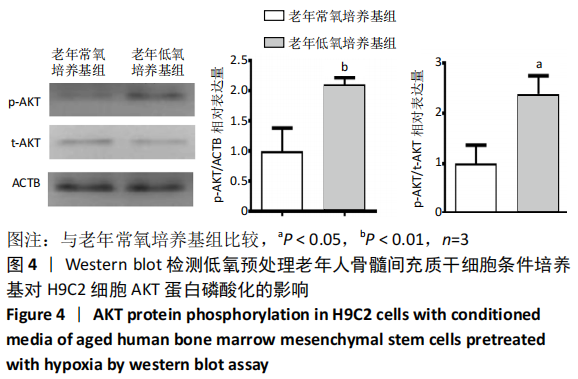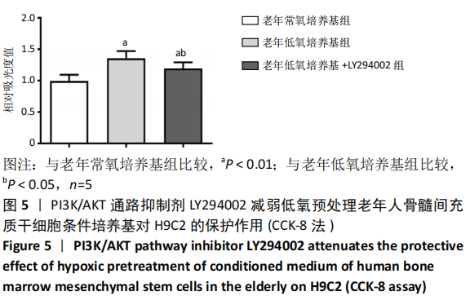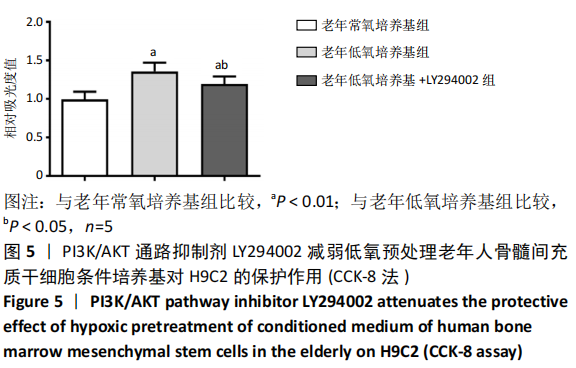Chinese Journal of Tissue Engineering Research ›› 2022, Vol. 26 ›› Issue (1): 1-6.doi: 10.12307/2022.001
Hypoxic pretreatment enhances the protective effect of aged human bone marrow mesenchymal stem cells conditioned medium against H9C2 oxidative stress damage
Song Huifang1, 2, Tan Jiayin2, Kang Yi3, Li Bin2, Bi Zhifei2, Long Nü2, Xia Zhongnian2, Guo Rui4
- 1First Hospital, 2Department of Human Anatomy, 3Shanxi Provincial Cancer Hospital, 4Morphology Laboratory, Shanxi Medical University, Taiyuan 030001, Shanxi Province, China
-
Received:2021-01-13Revised:2021-01-20Accepted:2021-02-23Online:2022-01-08Published:2021-10-23 -
Contact:Song Huifang, PhD, Associate professor, First Hospital, and Department of Human Anatomy, Shanxi Medical University, Taiyuan 030001, Shanxi Province, China Guo Rui, PhD, Senior experimentalist, Morphology Laboratory, Shanxi Medical University, Taiyuan 030001, Shanxi Province, China -
About author:Song Huifang, PhD, Associate professor, First Hospital, and Department of Human Anatomy, Shanxi Medical University, Taiyuan 030001, Shanxi Province, China -
Supported by:the National Natural Science Foundation of China, No. 81702239 (to SHF); the Natural Science Foundation of Shanxi Province, No. 201701D221252 (to SHF), No. 201801D221397 (to GR)
CLC Number:
Cite this article
Song Huifang, Tan Jiayin, Kang Yi, Li Bin, Bi Zhifei, Long Nü, Xia Zhongnian, Guo Rui. Hypoxic pretreatment enhances the protective effect of aged human bone marrow mesenchymal stem cells conditioned medium against H9C2 oxidative stress damage[J]. Chinese Journal of Tissue Engineering Research, 2022, 26(1): 1-6.
share this article
Add to citation manager EndNote|Reference Manager|ProCite|BibTeX|RefWorks
| [1] VIRANI SS, ALONSO A, BENJAMIN EJ, et al. Heart Disease and Stroke Statistics-2020 Update: A Report From the American Heart Association. Circulation. 2020;141(9):e139-e596. [2] 中国心血管健康与疾病报告编写组.中国心血管健康与疾病报告2019概要[J].中国循环杂志,2020,35(9):833-854. [3] ZHOU M, WANG H, ZENG X, et al. Mortality, morbidity, and risk factors in China and its provinces, 1990-2017: a systematic analysis for the Global Burden of Disease Study 2017. Lancet. 2019;394(10204): 1145-1158. [4] PRZYBYT E, HARMSEN MC. Mesenchymal stem cells: promising for myocardial regeneration? Curr Stem Cell Res Ther. 2013;8(4):270-277. [5] BEHJATI M. Selection of best door-to-cardiac regeneration (D2CR) time. ARYA Atheroscler. 2013;9(6):377-379. [6] LAFLAMME MA, MURRY CE. Heart regeneration. Nature. 2011; 473(7347):326-335. [7] PROWSE AB, TIMMINS NE, YAU TM, et al. Transforming the promise of pluripotent stem cell-derived cardiomyocytes to a therapy: challenges and solutions for clinical trials. Can J Cardiol. 2014;30(11):1335-1349. [8] CHEN B, ZHANG F, LI QY, et al. Protective Effect of Ad-VEGF-Bone Mesenchymal Stem Cells on Cerebral Infarction. Turk Neurosurg. 2016; 26(1):8-15. [9] GARCÍA GÓMEZ-HERAS S, LARGO C, LARREA JL, et al. Main histological parameters to be evaluated in an experimental model of myocardial infarct treated by stem cells on pigs. PeerJ. 2019;7:e7160. [10] KOT M, MUSIAŁ-WYSOCKA A, LASOTA M, et al. Secretion, migration and adhesion as key processes in the therapeutic activity of mesenchymal stem cells. Acta Biochim Pol. 2019;66(4):499-507. [11] HE L, CHEN X. Cardiomyocyte Induction and Regeneration for Myocardial Infarction Treatment: Cell Sources and Administration Strategies. Adv Healthc Mater. 2020;9(22):e2001175. [12] KESIDOU D, DA COSTA MARTINS PA, et al. Extracellular Vesicle miRNAs in the Promotion of Cardiac Neovascularisation. Front Physiol. 2020;11: 579892. [13] JIANG X, YANG Z, DONG M. Cardiac repair in a murine model of myocardial infarction with human induced pluripotent stem cell-derived cardiomyocytes. Stem Cell Res Ther. 2020;11(1):297. [14] LIANG C, LIU Z, SONG M, et al. Stabilization of heterochromatin by CLOCK promotes stem cell rejuvenation and cartilage regeneration. Cell Res. 2021;31(2):187-205. [15] KHANH VC, YAMASHITA T, OHNEDA K, et al. Rejuvenation of mesenchymal stem cells by extracellular vesicles inhibits the elevation of reactive oxygen species. Sci Rep. 2020;10(1):17315. [16] LI Q, ZHU Z, WANG C, et al. CTRP9 ameliorates cellular senescence via PGC‑1α/AMPK signaling in mesenchymal stem cells. Int J Mol Med. 2018;42(2):1054-1063. [17] 宋慧芳,郭蕊,张亮.低氧预处理通过激活AKT通路提高老年hBM-MSCs对氧化应激损伤的耐受能力[J].中国病理生理杂志,2016, 32(5):912-916. [18] SONG HF, HE S, LI SH, et al. Aged Human Multipotent Mesenchymal Stromal Cells Can Be Rejuvenated by Neuron-Derived Neurotrophic Factor and Improve Heart Function After Injury. JACC Basic Transl Sci. 2017;2(6):702-716. [19] ZHAI XY, YAN P, ZHANG J, et al. Knockdown of SIRT6 Enables Human Bone Marrow Mesenchymal Stem Cell Senescence. Rejuvenation Res. 2016;19(5):373-384. [20] SHARP TE 3RD, SCHENA GJ, HOBBY AR, et al. Cortical Bone Stem Cell Therapy Preserves Cardiac Structure and Function After Myocardial Infarction. Circ Res. 2017;121(11):1263-1278. [21] BIANCONI V, SAHEBKAR A, KOVANEN P, et al. Endothelial and cardiac progenitor cells for cardiovascular repair: A controversial paradigm in cell therapy. Pharmacol Ther. 2018;181:156-168. [22] MACARTHUR JW JR, COHEN JE, MCGARVEY JR, et al. Preclinical evaluation of the engineered stem cell chemokine stromal cell-derived factor 1α analog in a translational ovine myocardial infarction model. Circ Res. 2014;114(4):650-659. [23] SUN Z, XIE Y, LEE RJ, et al. Myocardium-targeted transplantation of PHD2 shRNA-modified bone mesenchymal stem cells through ultrasound-targeted microbubble destruction protects the heart from acute myocardial infarction. Theranostics. 2020;10(11):4967-4982. [24] DENG S, ZHOU X, GE Z, et al. Exosomes from adipose-derived mesenchymal stem cells ameliorate cardiac damage after myocardial infarction by activating S1P/SK1/S1PR1 signaling and promoting macrophage M2 polarization. Int J Biochem Cell Biol. 2019;114:105564. [25] MAO Q, LIANG XL, ZHANG CL, et al. LncRNA KLF3-AS1 in human mesenchymal stem cell-derived exosomes ameliorates pyroptosis of cardiomyocytes and myocardial infarction through miR-138-5p/Sirt1 axis. Stem Cell Res Ther. 2019;10(1):393. [26] HUANG P, WANG L, LI Q, et al. Atorvastatin enhances the therapeutic efficacy of mesenchymal stem cells-derived exosomes in acute myocardial infarction via up-regulating long non-coding RNA H19. Cardiovasc Res. 2020;116(2):353-367. [27] SUN CK, CHEN CH, CHANG CL, et al. Melatonin treatment enhances therapeutic effects of exosomes against acute liver ischemia-reperfusion injury. Am J Transl Res. 2017;9(4):1543-1560. [28] BAI Y, HAN YD, YAN XL, et al. Adipose mesenchymal stem cell-derived exosomes stimulated by hydrogen peroxide enhanced skin flap recovery in ischemia-reperfusion injury. Biochem Biophys Res Commun. 2018;500(2):310-317. [29] ZHANG S, CHUAH SJ, LAI RC, et al. MSC exosomes mediate cartilage repair by enhancing proliferation, attenuating apoptosis and modulating immune reactivity. Biomaterials. 2018;156:16-27. [30] WANG T, JIAN Z, BASKYS A, et al. MSC-derived exosomes protect against oxidative stress-induced skin injury via adaptive regulation of the NRF2 defense system. Biomaterials. 2020;257:120264. [31] LI F, ZHANG J, LIAO R, et al. Mesenchymal stem cell‑derived extracellular vesicles prevent neural stem cell hypoxia injury via promoting miR‑210‑3p expression. Mol Med Rep. 2020;22(5): 3813-3821. [32] PAN W, ZHU Y, MENG X, et al. Immunomodulation by Exosomes in Myocardial Infarction. J Cardiovasc Transl Res. 2019;12(1):28-36. [33] GONG XH, LIU H, WANG SJ, et al. Exosomes derived from SDF1-overexpressing mesenchymal stem cells inhibit ischemic myocardial cell apoptosis and promote cardiac endothelial microvascular regeneration in mice with myocardial infarction. J Cell Physiol. 2019;234(8): 13878-13893. [34] GENG T, SONG ZY, XING JX, et al. Exosome Derived from Coronary Serum of Patients with Myocardial Infarction Promotes Angiogenesis Through the miRNA-143/IGF-IR Pathway. Int J Nanomedicine. 2020;15: 2647-2658. [35] WILSON A, LAURENTI E, OSER G, et al. Hematopoietic stem cells reversibly switch from dormancy to self-renewal during homeostasis and repair. Cell. 2008;135(6):1118-1129. [36] YAMAKAWA H, KUSUMOTO D, HASHIMOTO H, et al. Stem Cell Aging in Skeletal Muscle Regeneration and Disease. Int J Mol Sci. 2020; 21(5):1830. [37] APOSTOLOPOULOU M, KIEHL TR, WINTER M, et al. Non-monotonic Changes in Progenitor Cell Behavior and Gene Expression during Aging of the Adult V-SVZ Neural Stem Cell Niche. Stem Cell Reports. 2017;9(6):1931-1947. [38] LI J, LI SH, DONG J, et al. Long-term repopulation of aged bone marrow stem cells using young Sca-1 cells promotes aged heart rejuvenation. Aging Cell. 2019;18(6):e13026. [39] LI J, HANSEN KC, ZHANG Y, et al. Rejuvenation of chondrogenic potential in a young stem cell microenvironment. Biomaterials. 2014;35(2): 642-653. [40] SPEHAR K, PAN A, BEERMAN I. Restoring aged stem cell functionality: Current progress and future directions. Stem Cells. 2020;38(9): 1060-1077. [41] ARTHUR SA, BLAYDES JP, HOUGHTON FD. Glycolysis Regulates Human Embryonic Stem Cell Self-Renewal under Hypoxia through HIF-2α and the Glycolytic Sensors CTBPs. Stem Cell Reports. 2019;12(4):728-742. [42] ABDOLMOHAMMADI K, MAHMOUDI T, NOJEHDEHI S, et al. Effect of Hypoxia Preconditioned Adipose-Derived Mesenchymal Stem Cell Conditioned Medium on Cerulein-Induced Acute Pancreatitis in Mice. Adv Pharm Bull. 2020;10(2):297-306. [43] 侯婧瑛,于萌蕾,郭天柱,等.低氧预处理激活HIF-1a/MALAT1/VEGFA通路促进骨髓间充质干细胞生存和血管再生[J].中国组织工程研究,2021,25(7):985-990. [44] WANG BH, LIEW D, HUANG KW, et al. The Challenges of Stem Cell Therapy in Myocardial Infarction and Heart Failure and the Potential Strategies to Improve the Outcomes. Nano LIFE. 2018;8(4):1841008. [45] LYU Y, XIE J, LIU Y, et al. Injectable Hyaluronic Acid Hydrogel Loaded with Functionalized Human Mesenchymal Stem Cell Aggregates for Repairing Infarcted Myocardium. ACS Biomater Sci Eng. 2020;6(12):6926-6937. [46] DATTA CHAUDHURI R, BANIK A, MANDAL B, et al. Cardiac-specific overexpression of HIF-1α during acute myocardial infarction ameliorates cardiomyocyte apoptosis via differential regulation of hypoxia-inducible pro-apoptotic and anti-oxidative genes. Biochem Biophys Res Commun. 2021;537:100-108. [47] HE Y, LU X, CHEN T, et al. Resveratrol protects against myocardial ischemic injury via the inhibition of NF‑κB‑dependent inflammation and the enhancement of antioxidant defenses. Int J Mol Med. 2021;47(3):1. [48] WANG AD, DAI LF, YANG L, et al. Upregulation of miR-335 reduces myocardial injury following myocardial infarction via targeting MAP3K2. Eur Rev Med Pharmacol Sci. 2021;25(1):344-352. [49] HUANG JJ, SHI YQ, LI RL, et al. Therapeutic ultrasound protects HUVECs from ischemia/hypoxia-induced apoptosis via the PI3K-Akt pathway. Am J Transl Res. 2017;9(4):1990-1999. [50] ZHANG H, WANG P, ZHANG X, et al. SDF1/CXCR4 axis facilitates the angiogenesis via activating the PI3K/AKT pathway in degenerated discs. Mol Med Rep. 2020;22(5):4163-4172. [51] LIU H, SUN X, GONG X, et al. Human umbilical cord mesenchymal stem cells derived exosomes exert antiapoptosis effect via activating PI3K/Akt/mTOR pathway on H9C2 cells. J Cell Biochem. 2019;120(9): 14455-14464. [52] WEI P, ZHONG C, YANG X, et al. Exosomes derived from human amniotic epithelial cells accelerate diabetic wound healing via PI3K-AKT-mTOR-mediated promotion in angiogenesis and fibroblast function. Burns Trauma. 2020;8:tkaa020. [53] WU ZL, DAVIS JRJ, ZHU Y. Dexmedetomidine Protects against Myocardial Ischemia/Reperfusion Injury by Ameliorating Oxidative Stress and Cell Apoptosis through the Trx1-Dependent Akt Pathway. Biomed Res Int. 2020;2020:8979270.
(责任编辑:MZH,ZN,JY)
|
| [1] | Wang Jing, Xiong Shan, Cao Jin, Feng Linwei, Wang Xin. Role and mechanism of interleukin-3 in bone metabolism [J]. Chinese Journal of Tissue Engineering Research, 2022, 26(8): 1316-1322. |
| [2] | Xiao Hao, Liu Jing, Zhou Jun. Research progress of pulsed electromagnetic field in the treatment of postmenopausal osteoporosis [J]. Chinese Journal of Tissue Engineering Research, 2022, 26(8): 1323-1329. |
| [3] | An Weizheng, He Xiao, Ren Shuai, Liu Jianyu. Potential of muscle-derived stem cells in peripheral nerve regeneration [J]. Chinese Journal of Tissue Engineering Research, 2022, 26(7): 1183-1190. |
| [4] | Fan Yiming, Liu Fangyu, Zhang Hongyu, Li Shuai, Wang Yansong. Serial questions about endogenous neural stem cell response in the ependymal zone after spinal cord injury [J]. Chinese Journal of Tissue Engineering Research, 2022, 26(7): 1191-1197. |
| [5] | Tian Chuan, Zhu Xiangqing, Yang Zailing, Yan Donghai, Li Ye, Wang Yanying, Yang Yukun, He Jie, Lü Guanke, Cai Xuemin, Shu Liping, He Zhixu, Pan Xinghua. Bone marrow mesenchymal stem cells regulate ovarian aging in macaques [J]. Chinese Journal of Tissue Engineering Research, 2022, 26(7): 1033-1039. |
| [6] | Hou Jingying, Guo Tianzhu, Yu Menglei, Long Huibao, Wu Hao. Hypoxia preconditioning targets and downregulates miR-195 and promotes bone marrow mesenchymal stem cell survival and pro-angiogenic potential by activating MALAT1 [J]. Chinese Journal of Tissue Engineering Research, 2022, 26(7): 1053-1059. |
| [7] | Zhou Ying, Zhang Huan, Liao Song, Hu Fanqi, Yi Jing, Liu Yubin, Jin Jide. Immunomodulatory effects of deferoxamine and interferon gamma on human dental pulp stem cells [J]. Chinese Journal of Tissue Engineering Research, 2022, 26(7): 1060-1067. |
| [8] | Liang Xuezhen, Yang Xi, Li Jiacheng, Luo Di, Xu Bo, Li Gang. Bushen Huoxue capsule regulates osteogenic and adipogenic differentiation of rat bone marrow mesenchymal stem cells via Hedgehog signaling pathway [J]. Chinese Journal of Tissue Engineering Research, 2022, 26(7): 1068-1074. |
| [9] | Wang Jifang, Bao Zhen, Qiao Yahong. miR-206 regulates EVI1 gene expression and cell biological behavior in stem cells of small cell lung cancer [J]. Chinese Journal of Tissue Engineering Research, 2022, 26(7): 1075-1079. |
| [10] | Liu Feng, Peng Yuhuan, Luo Liangping, Wu Benqing. Plant-derived basic fibroblast growth factor maintains the growth and differentiation of human embryonic stem cells [J]. Chinese Journal of Tissue Engineering Research, 2022, 26(7): 1080-1085. |
| [11] | Wen Dandan, Li Qiang, Shen Caiqi, Ji Zhe, Jin Peisheng. Nocardia rubra cell wall skeleton for extemal use improves the viability of adipogenic mesenchymal stem cells and promotes diabetes wound repair [J]. Chinese Journal of Tissue Engineering Research, 2022, 26(7): 1086-1092. |
| [12] | Zhu Bingbing, Deng Jianghua, Chen Jingjing, Mu Xiaoling. Interleukin-8 receptor enhances the migration and adhesion of umbilical cord mesenchymal stem cells to injured endothelium [J]. Chinese Journal of Tissue Engineering Research, 2022, 26(7): 1093-1098. |
| [13] | Luo Xiaoling, Zhang Li, Yang Maohua, Xu Jie, Xu Xiaomei. Effect of naringenin on osteogenic differentiation of human periodontal ligament stem cells [J]. Chinese Journal of Tissue Engineering Research, 2022, 26(7): 1099-1104. |
| [14] | Wang Xinmin, Liu Fei, Xu Jie, Bai Yuxi, Lü Jian. Core decompression combined with dental pulp stem cells in the treatment of steroid-associated femoral head necrosis in rabbits [J]. Chinese Journal of Tissue Engineering Research, 2022, 26(7): 1122-1127. |
| [15] | Fang Xiaolei, Leng Jun, Zhang Chen, Liu Huimin, Guo Wen. Systematic evaluation of different therapeutic effects of mesenchymal stem cell transplantation in the treatment of ischemic stroke [J]. Chinese Journal of Tissue Engineering Research, 2022, 26(7): 1133-1140. |
| Viewed | ||||||
|
Full text |
|
|||||
|
Abstract |
|
|||||
